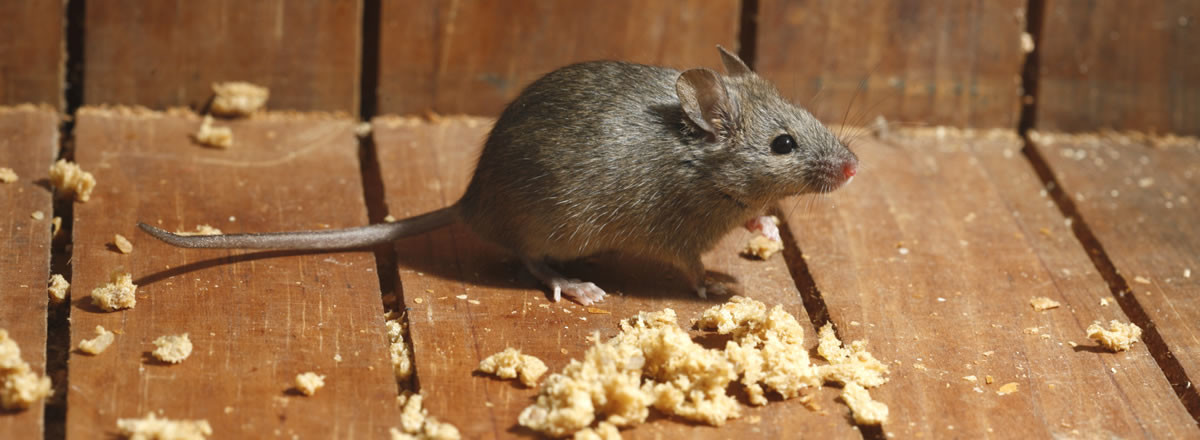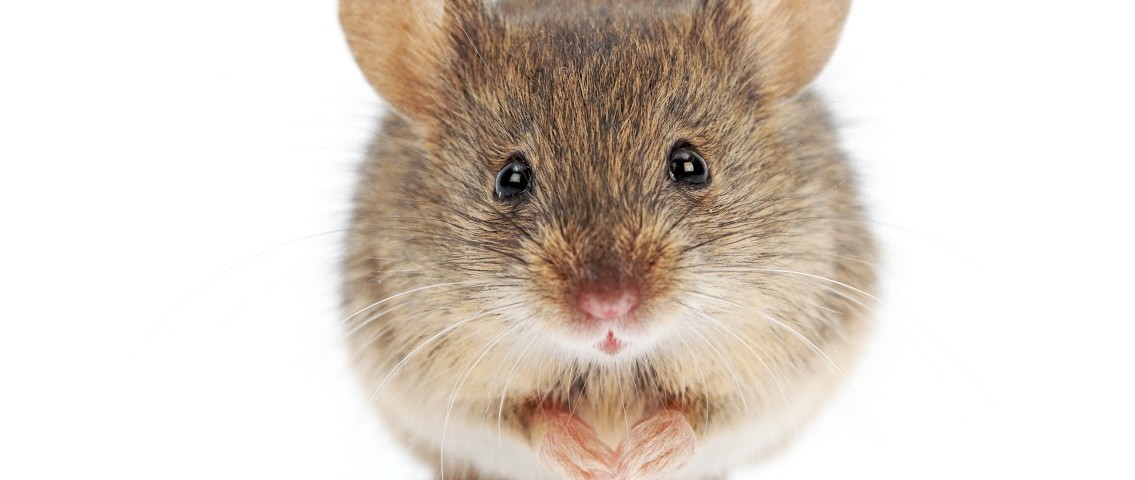Information and Facts About the House Mouse
The house mouse is a small rodent that lives in the habitations of humans. Unlike the rat, a house mouse is very small and does not cause as much structural damage to the house they live in. However, they can contaminate any food sources in a building by breaking into the cupboards and leaving dropping near food. They are also dangerous in that they can easily pass parasites and diseases to humans through their droppings or saliva. The easiest way that you can tell you have a mouse infestation is little chewing marks on your food containers and cupboards.
The house mouse is easily recognizable. It is small, measuring only up to eight inches from nose to tail. The house mouse can come in a variety of colors from white, black, brown and gray. The nose, ears and tail are pink with just a touch of hair and it is generally described as very cute. House mice are formidable survivors, being able to survive in even the most unfavorable conditions. They can live anywhere that offers a bit of warmth and protection from the elements; this could be in a barn, in a shed, a house, a car or woodpiles. However, the only place that they are sure to live is around humans because our crumbs are what they eat.
House mice are not only a successful species because they are adaptable to any environment, they also reproduce very quickly. A female mouse will go into heat whenever there is a male present and she will be in heat for anywhere between 4-6 days. The house mice’s gestation period lasts anywhere between 19 and 21days, allowing one female to produce 5 to 10 litters of 3-14 babies a year. Male mouse reach sexual maturity at 6 weeks and a female mouse will reach maturity at 8 weeks. All of this contributes to having a very big house mouse problem very quickly if the conditions are right to produce rampant and frenzied breeding. The average life expectancy for a house mouse is less than a year, but if it is raised in captivity or has found a sheltered environment, the house mouse could live up to four years.
Most house mice will run and stand on all fours but stand in the upright position when eating or fighting. Mice communicate in several different ways. For example, house mice will communicate through what humans hear as squeaks, but they also will communicate using pheromones located in their urine or tear fluids. Mice will use their whiskers to sense movement on all types of surfaces and in air pressures.
Mouse Diseases
According to the Center for Disease Control (CDC), mice spread numerous diseases worldwide. The diseases are spread to humans directly: through contact with mice feces, saliva or urine, mouse bites and mere contact. Mouse diseases, however, can also be spread indirectly: ticks, fleas and mites that have fed, at some point, on the infected mouse and then transmit that infection to humans.
Diseases That Mice Can Transmit
Hantavirus
Hantavirus is a life-threatening disease transmitted by rodents, particularly deer mice. The virus is found in rodent urine and feces, but it does not make the host animal sick. It is believed that humans can become sick if they come in contact with contaminated dust from mice nests or droppings. However, hantavirus is not spread from humans to humans.
The early symptoms of the disease are: chills, muscle aches and fever. Symptoms can quickly worsen: dry cough, headache, shortness of breath, nausea and vomiting and general malaise.
Salmonella
Salmonella is a bacteria food-borne illness. It is transmitted when mice and other rodents like rats contaminate food or working surfaces where food is prepared. Common symptoms that are developed by people who have contracted salmonella, include fever, abdominal cramps and diarrhea that last for up to 7 days. Young children and the elderly are at higher risk to salmonella. In recent years, numerous salmonella outbreaks have been linked to rodents, especially feeder rodents (live or frozen rats and mice used to feed pets such as reptiles).
Signs of Mice in your Home
Of course not all mouse infestations are exactly the same. Nevertheless, there are a number of common signs and indicators you can look for to help determine if you have a mouse problem in your home.
- Mouse Droppings – Usually the most easily identifiable sign of mice in any home. Mice produce a lot of droppings throughout the day and they’re usually found along walls, in cupboards or under sinks. They are the size of a grain of rice, pointed at one or both ends and typically brown to black in color. The average length of a House mouse’s dropping is ¼ inch.
- Dirty Smudges – Look for dirty smudges on floors or baseboards. Mice tend to run alongside walls as they don’t have great eyesight and they tend to stick to the same route too. Over time the increased contact from their fur and body along the same stretch of wall leads to distinctive marks. You might also notice small patches of urine along the same route.
- Distinctive Smell – Noticed a funny smell recently? The presence of mice may also be established through a distinctive ammonia-like smell (very strong urine smell) that will be particularly obvious in more enclosed areas such as in cupboards. The smell helps mice orientate inside a home as it is often stronger along established routes and acts as a marker for their territory.
- Mouse Damage – Mice damage can include damage to furniture and wiring as well as to stored foods and other readily available food sources, leading to food contamination from their feces, urine or fur, which may cause Salmonella or rodent related diseases.
- Mice have teeth that grow continuously and they need to gnaw on wood, plastic, cables and other hard materials to keep their teeth shorter. This is also the reason why mice can be seen as a fire hazard, as they are able to chew through electrical cables causing equipment malfunctions and power shortages.In terms of food damage, they can make up to 20-30 visits per day to an identified food site. Adults will consume between 3 and 4 grams of food in one day and they prefer cereal grains, seeds, nuts, meats and candies. It is also important to note that they are fond of foods high in fat too, such as nuts, bacon, butter and sweets.
- Scratching Noises – Listen out for unusual or unfamiliar noises, especially at night when mice are most active. You may hear scratching noises in the walls or noises coming from ceilings above your head as mice scurry around. You might also hear them squeaking or gnawing.
- Mouse nests – Keep a look out for nests. Mice build nests with shredded material such as newspaper and fabrics. Nests tend to be in hidden places such as behind fridges, voids in walls, ceilings, cabinets and storage boxes etc., and relatively close to food sources. Nests will often contain young mice.
- Live or dead mice – Spotting a mouse during the daytime can be an indication of a heavy infestation.
Mice in the Attic
Mice are very crafty and they can fit into the smallest of spaces. Your average house mouse can fit into cracks or holes smaller than an inch in diameter.
Certain mice are also excellent climbers, and they will try to go where they can find the warmest areas and the most material they can use to make their nests. This is why your attic, where all of the heat from your home gathers and is often loaded with plenty of nest-building material, is often the most popular place for mice to infest.
What’s that Noise?
Given the fact that you may not spend much time in the attic of your home, another aspect that mice find pleasing it is that they get left alone. Even if you use the upstairs or upper levels of your home for an office or bedroom, mice can still get behind the walls, looking for insulation.
One of the first indications that you might have a mouse or rodent problem is the sound of scurrying feet in your walls. You will most often hear these at night since mice are nocturnal and will head out looking for food at night. You might also hear them chewing on wood in the walls.
Once a mouse finds its way into the attic, it will start tearing up the insulation and using that to build a nest. Of course, this can also send insulation particles into the air where they can be sucked up by the air conditioning unit and spread around the house.
What Do Mice Eat?
One of the questions that is most commonly asked of us is, “What do mice eat?”
Mice are looking for a warm place to live, build nest and have babies. To do this, they need the right materials, like paper, to build those nests and most importantly, an easy supply of food.
Mouse Feeding Habits?
Mice are omnivores. That means that they will eat pretty much anything, including both meat and plant-based food. Mice in the wild are a little different and most of them are herbivores, meaning that they eat mostly plants. Grains, oats, cereal, corn, fruits and seeds are all on a mouse’s menu in the wild. Some species hunt small insects or other pests.
A house mouse, has adapted to urban living. They are evolved to eat just about anything. They look for food scraps in the garbage. They eat both plants and meats and just about anything they can chew. House mice are not above chewing through bags and other containers to get to food.
Do Mice Eat Cheese?
If you spent any time watching cartoons you might think that mice eat cheese. This isn’t entirely true. Most mice like things loaded in carbohydrates, although there might be times when even a piece of cheese seems appetizing to the average house mouse.
A mouse might prefer peanut butter over cheese, for example. It has also been shown that chocolate is appealing to mice. Mice are fond of fruits and other sweets, so they may decide to bite on sweet things. However, they are opportunistic and will take a chance on most anything.
What Else Do They Eat?
As you may already know, mice are known for doing damage to things like walls, wood and electrical wires. This is because mice and other rodents are known to gnaw on things that are not food. They have teeth that are constantly growing and have this compulsion to gnaw. This is when they can really become destructive.
Once mice get into the walls, they will gnaw through the wood. They will create holes in furniture, cabinets and the baseboards. They also will chew on the rubber insulation that surround electrical wires. They might also bit right through the wires themselves, shorting out electrical devices and creating a potential fire hazard.



